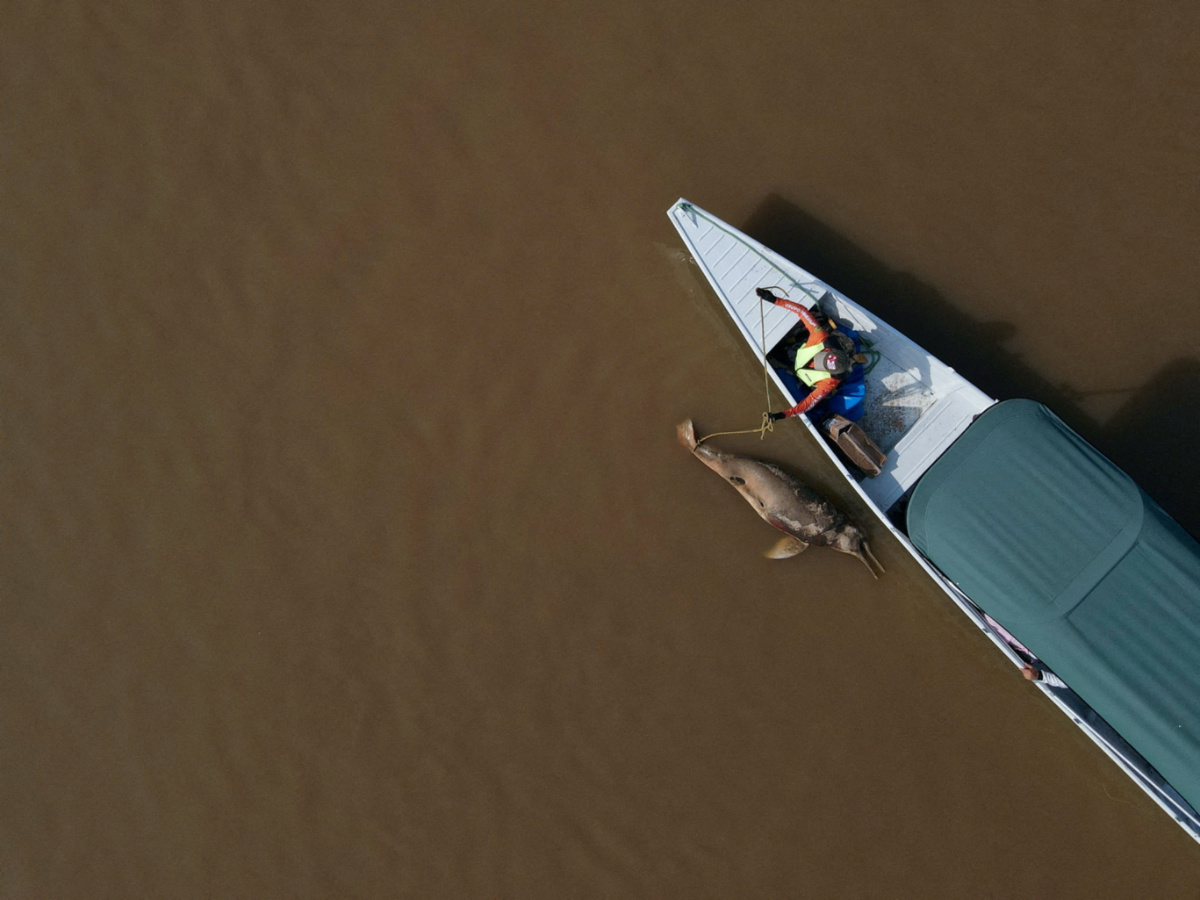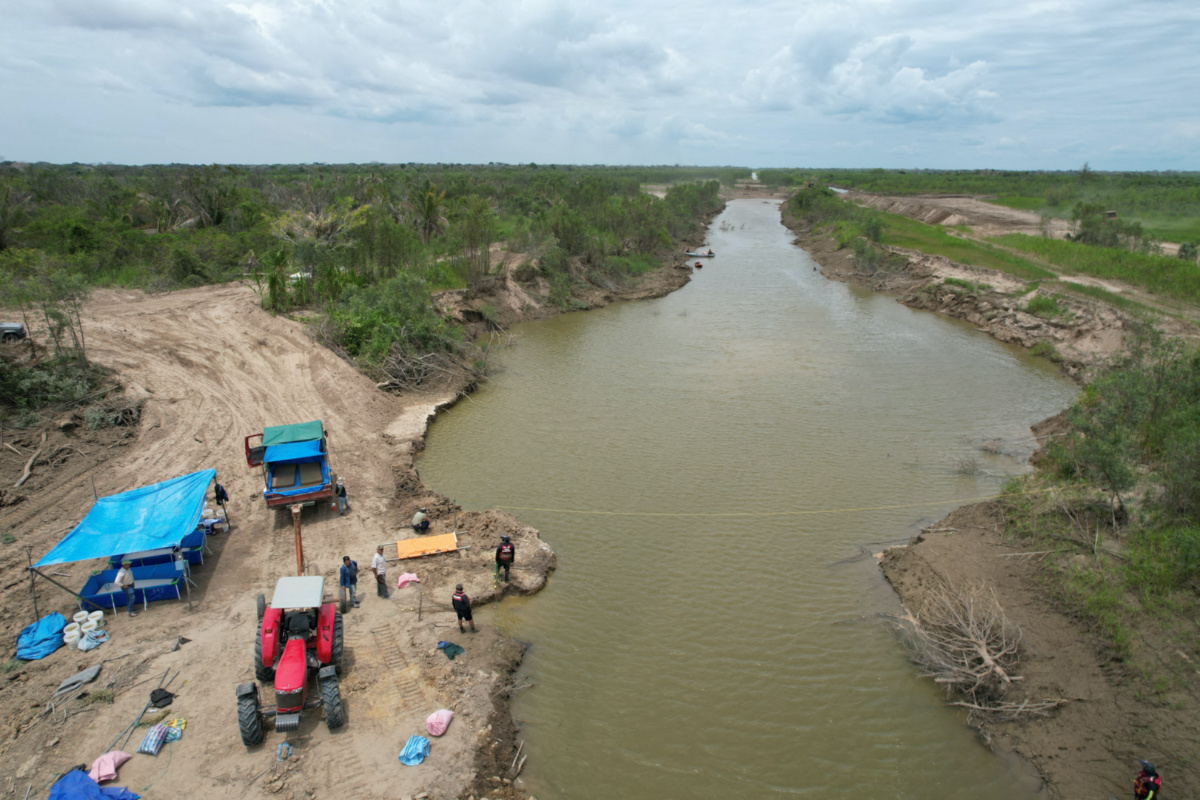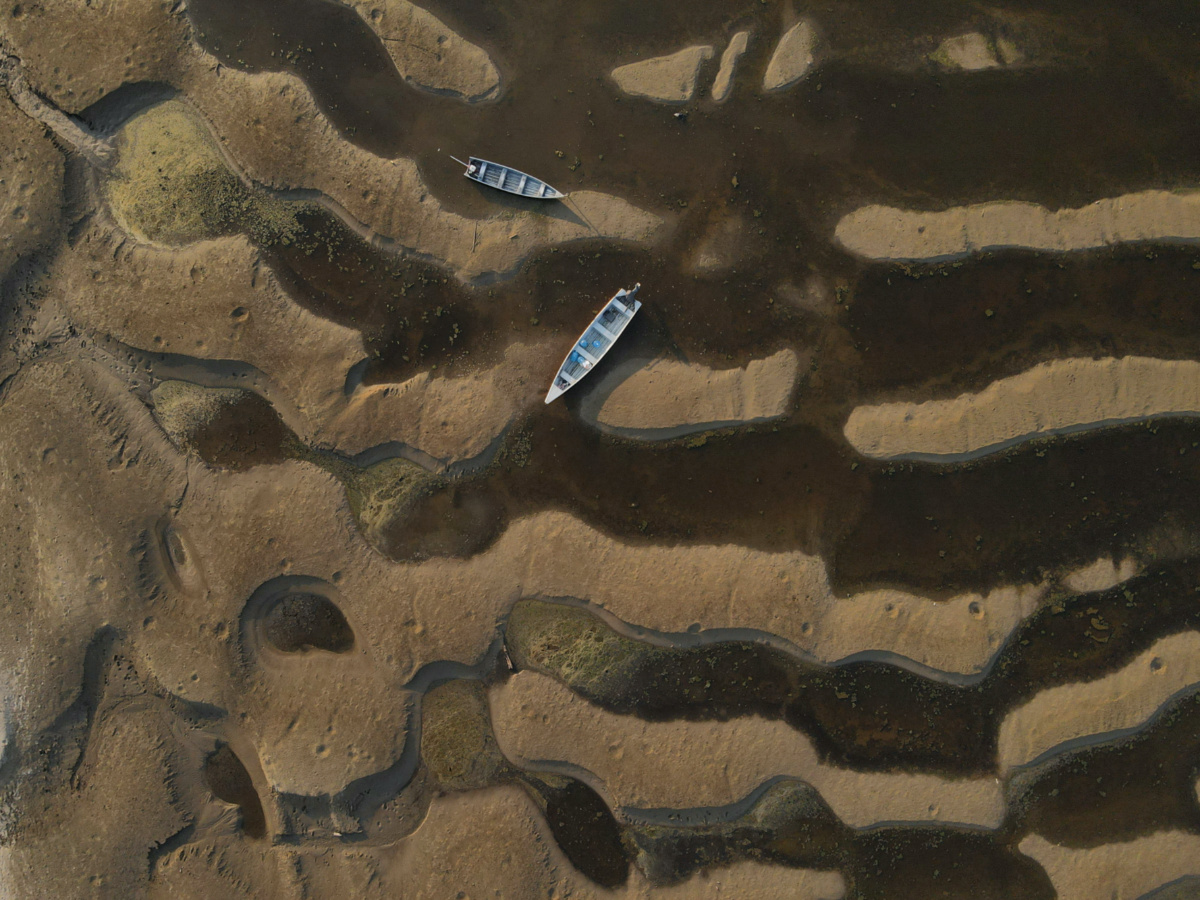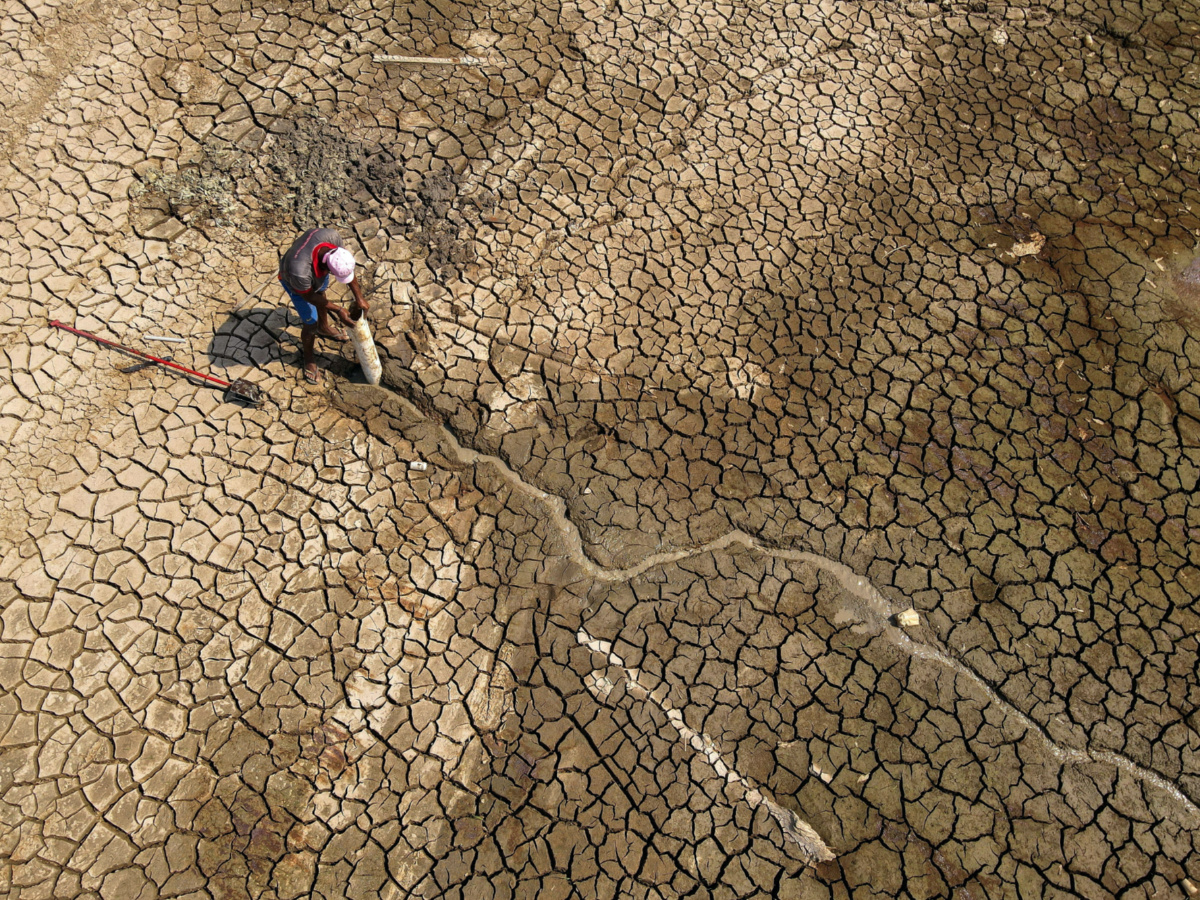
BRAD HAYNES and JAKE SPRING, of Reuters, report on the devastating impact of the drought gripping northern Brazil, Guyana, Suriname, French Guiana and parts of Venezuela and Colombia…
Manaus, Brazil
Reuters
The Amazon rainforest’s record-breaking drought hit home for Raimundo Leite de Souza one October morning, he said, when he woke to find the stream that runs behind his house had dropped nearly a foot overnight, stranding his skiff in a mudflat.
As weeks passed, Souza said, rotting fish washed up on the banks of the Jaraqui, a tributary of the Rio Negro. Rodents thrashed in the mud searching for water. Carcasses of caimans and cobras turned up in the forest.
Finally Souza, an innkeeper and community leader in Bela Vista do Jaraqui, said he rallied two dozen neighbours to drill a 60-metre well in the heart of the world’s largest freshwater basin.
“Never in my 37 years have I seen anything like this happen to our stream,” he said.

A dead dolphin is seen at Tefe Lake which had been affected by the high temperatures and drought in Tefe, Amazonas state, Brazil, on 1st October, 2023. PICTURE: Reuters/Bruno Kelly
Driven by climate change, the drought gripping northern Brazil, Guyana, Suriname, French Guiana and parts of Venezuela and Colombia has sapped the Amazon River and four of its biggest tributaries to their lowest levels in at least half a century.
It has killed endangered river dolphins and triggered deadly riverbank collapses. With rivers forming the backbone of transportation across theAmazon region, the drought has disrupted access to food and medicine in dozens of cities. And, in one of the world’s top food producers, it has wiped as much as 10 million metric tons off initial forecasts for next year’s soybean crop.
“Even if we don’t knock down one more tree, the Amazon could reach its point of no return.”
– Brazilian President Luiz Inacio Lula da Silva, speaking at COP28
In a threat to the global climate, the drought could also double the mortality rate of the rainforest’s largest trees, releasing the huge amounts of climate-warming carbon they collectively store in their wood, according to scientists.
The Amazon, the world’s largest rainforest, is regarded by scientists as a bulwark against climate change because its dense vegetation absorbs carbon and emits oxygen.
“Even if we don’t knock down one more tree, the Amazon could reach its point of no return,” Brazilian President Luiz Inacio Lula da Silva warned the United Nations COP28 climate summit on Friday.
The worst may be yet to come, with experts predicting an even more intense drought next year.
Reuters interviewed nine scientists who said the drought, which began in April, is likely to weaken the annual rainy season now underway, and last until the next rainy season in late 2024.
Five of those scientists said the Amazon is unlikely to make a full recovery before early 2026, at best, because it may take two healthy rainy seasons to restore the forest’s normal soil moisture.
“This is the overture,” said Michael Coe, director of the tropics program at the US-based Woodwell Climate Research Center, and one of the scientists expecting the effects of the drought to linger into 2026. “Where we are now, we’re just getting started.”
The five researchers predicting a 2026 recovery said the effects of the drought could endure even longer if El Nino is prolonged.
The naturally occurring phenomenon roils global weather every two to seven years, warming waters off the Pacific coast of South America and pulling rains in that direction while depressing precipitation in the Amazon.
Four of the scientists said it was hard to predict precisely when the rainforest would recover from this drought, given the uncertainty in any long-term weather forecast.

Volunteers at the Noel Kempff Mercado Natural History Museum set a perimetre with a net as they rescue pink dolphins trapped in shallow water after they were unable to follow the natural course of the Rio Grande riverbed, in Rio Grande, in Santa Cruz de la Sierra, Bolivia on 27th November, 2023. PICTURE: Noel Kempff Mercado Natural History Museum/Handout via Reuters
The scientists said the drought is being caused by warming in the tropical North Atlantic Ocean and off South America’s Pacific Coast, phenomena that are becoming more extreme with climate change. Coe called it a “double whammy.”
Rains tend to track the hottest areas of the ocean. Seawater evaporates and is carried high into the atmosphere by rising air currents.
North Atlantic temperatures soared to all-time highs in August and September, with water off Florida’s coast reaching hot tub temperatures of 38.4 degrees Celsius (101 F).
Those warmer waters pulled the band of rains known as the Intertropical Convergence Zone further toward North America and away from theAmazon, making May to October – the jungle’s dry season – even drier this year.
Meanwhile, the rains that would typically deluge the Amazon starting in November are being dampened by the effects of El Nino.
“We’ve had climate models showing that you get super El Ninos because of global warming, which is what we’re having now,” said Philip Fearnside, an ecologist at the National Institute of Amazonian Research.
The lack of rain is draining the soil deep beneath the Amazon forest and that moisture is unlikely to recharge until heavy rains return, around November next year, the scientists told Reuters.
“In the last 15 years, this is probably the fourth ‘drought of the century’ over the Amazon,” said Henrique Barbosa, a physicist who studies tropical forests at University of Maryland, Baltimore. “This is way worse than the ones we had before.”
The drought has played havoc in a vast region – larger than Western Europe – that relies on its rivers for food, transportation and commerce.
Brazil’s Amazonas state, the hardest hit, declared a public emergency in September, and has delivered drinking water and more than 1,000 tons of rice, beans and other staples via aircraft and smaller boats that can navigate shallow waters.
The state has deployed helicopters to airlift the sick to hospital and set up remote learning for some 7,000 students who can no longer get to school.
Brazil’s federal government has pledged 628 million reais ($US129 million) toward relief, including medical supplies, reinforcements to fight forest fires and dredging to ease boat traffic, with plans for more dredging next year.
“The issue we’re confronting now is adaptation to these climate changes, and the cost is still unimaginable,” Amazonas Environment Secretary Eduardo Taveira said in an interview in the state capital Manaus.
Outside, smoke from forest fires blotted the horizon.
“One abnormal year – or maybe two, three in a row – it starts to overwhelm our structures,” Taveira said.

Canoes are seen at the dry riverbed of the Paraua River during a historic drought in the Amazon, in Careiro da Varzea, Amazonas state, Brazil, on 26th October, 2023. PICTURE: ReutersBruno Kelly/File photo
The economic costs for Brazil, the world’s 11th largest economy, are mounting.
In Itacoatiara, near the meeting of the Amazon and Madeira Rivers, part of a $US15 million port collapsed in October as dry, loose soil gave way, just five years after its inauguration.
The port of Manaus recorded its lowest water levels in 121 years, disrupting access for container ships for more than 50 days.
Assembly lines idled at the Manaus free trade zone where Honda, LG and other companies assemble consumer goods from imported parts. Electronics maker Positivo Tecnologia slashed its 2023 revenue forecast by 15 to 35 per cent, warning of disrupted deliveries for the Christmas season.
The barges that carry more than 40 per cent of Brazil’s grain exports to northern ports have been running at half capacity.
In farm country, the drought has forced many producers to plant one crop this year instead of two, knocking millions of tons off next year’s soy and corn forecasts.
We rely on our readers to fund Sight's work - become a financial supporter today!
For more information, head to our Subscriber's page.
The forest itself is also being pushed to its limit, scientists said. Trees, stressed by hot and dry conditions, are shedding more leaves and leaving more debris on the ground to feed forest fires.
“That is just the perfect combination for a big barbecue of the Amazon,” said Paulo Brando, an ecologist at Yale University.
Severe and repeated droughts affect the moisture levels deep in the soil where the largest trees plunge their roots.
The loss of these jungle giants may push the forest even faster toward a point of no return, leading large sections of the forest to die off, he said.
Brando estimates that the normal big tree mortality rate can double to three per cent or more in extreme drought years – which could have huge impacts on global greenhouse gas emissions.
“The big trees, if they start dying at a higher rate, they store most of the carbon,” Brando said.

Ivalmir Silva searches for water on Puraquequara Lake, which has been affected by drought, in Manaus Brazil, on 6th October, 2023. PICTURE: Reuters/Bruno Kelly/File photo
If drought-like conditions become permanent with climate change, as some long-range climate models suggest, the Amazon biome could lose one-sixth to one-half of its area, or one million to three million square kilometres, according to computer simulations run by Barbosa.
That would release huge amounts of carbon dioxide, contributing to climate change and wiping out a wealth of plant and animal species found only in the Amazon.
“The effects that we’re seeing this year, if they were to persist, that would be tragic,” Barbosa said.






